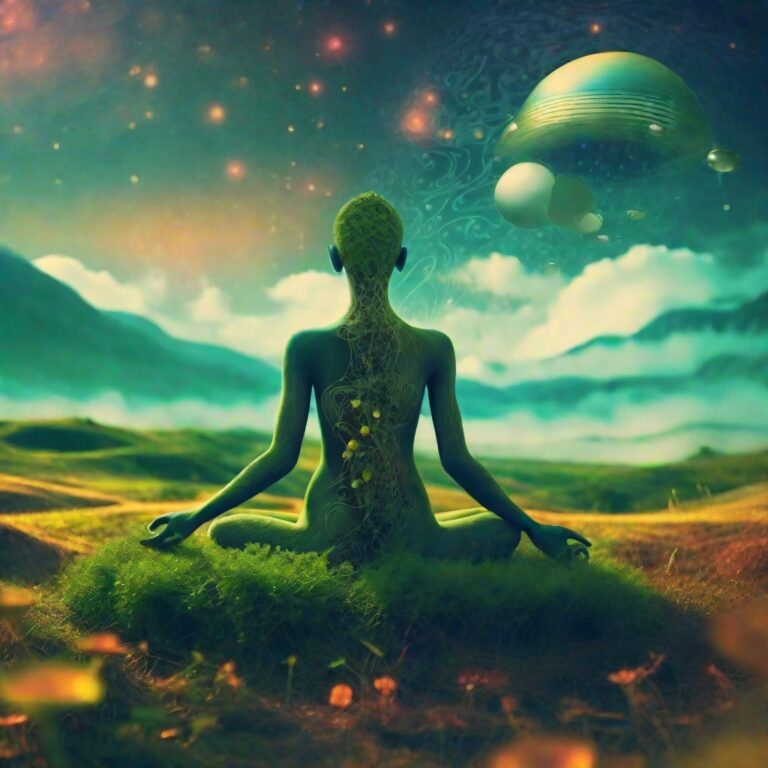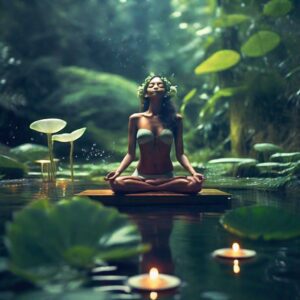Table of Contents
The Soothing Sounds of Organic Ambient Music: A Guide to the Acoustic, Natural Side of Ambient
Ambient music emerged in the 1970s as an experimental genre focused on creating soothing atmospheric backgrounds or “sonic landscapes” (soundscapes).
Over time, many styles of ambient music developed, from the synth-heavy Berlin school to drone-based isolationism. One particular subgenre stands out for its use of natural, acoustic sounds – organic ambient. Let’s explore the origins and defining qualities of this calming, nature-inspired style.
From Environmental Records to Ethereal Soundscapes: The Evolution of Organic Ambient
Ambient pioneer Brian Eno‘s early albums like Discreet Music and Ambient 1: Music for Airports set the template for the genre’s open, amorphous quality. Eno incorporated instruments like piano, synthesizer, and guitar in tandem with tape loops and processed sounds.
This innovative fusion of electronic and traditional instrumentation could be seen as an early precursor to organic ambient.
Throughout the 1980s, artists started moving away from purely electronic tones toward more “natural” textures.
Musicians like Steve Roach, Robert Rich, and Vidna Obmana pioneered a style that blended organic instrumentation, field recordings, and an expansive production style. Lush reverbs, drifting pads, and wide stereo imaging created an immersive listening experience.

This organically-inclined ambient gained steam in the ’90s thanks to labels like Projekt, Green House Music, and Waveform Records. Bands like O Yuki Conjugate, Numina, and Loren Nerell crafted cosmic soundworlds teeming with acoustic instruments, found sounds, and an intricate sense of space. As technology improved, artists had access to higher-fidelity field recordings, allowing more seamless integration of natural textures.
Today, organic ambient encompasses a range of approaches from the folk-tinged songwriting of Julianna Barwick to Tangerine Dream-esque soundscapes by artists like 36. Whether it’s a piano melody weaving through a tapestry of rainforest audio or a softly strummed acoustic guitar over a cloud of harmonium drones, organic ambient music retains a transcendent, meditative quality. But what exactly defines this style?
Defining the Dreamy, Hypnotic Qualities of Organic Ambient music.
Organic ambient music is marked first and foremost by its use of natural, acoustic timbres and environmental recordings.
The music tends to have an evolutionary, open-ended flow rather than a traditional song structure. Organic ambience conveys a sense of timelessness and mental spaciousness. Let’s explore some of the core qualities that set this genre apart:
Textural Richness – Field recordings, instrumental tones, electronics, and processed sounds interweave to create lush, detailed aural palettes. The focus is on the composite sound rather than individual melodic lines.
Meditative Qualities – Organic ambient often has a slow pace and hypnotic rhythms that evoke introspection and deep calm. The music seems to breathe and drift gradually like natural phenomena.
Spaciousness – Expansive reverbs, patient development, and wide stereo positioning give organic ambient music a sense of three-dimensional space and “airiness”. The sounds enfold the listener.
Melodic Subtlety – While not devoid of melody, organic ambient tends to favor sustained tones, sparse piano lines, and floating accompaniment patterns rather than strong hooks. The melodies disappear into the larger texture.
Natural Variability – Rather than exact repetition, organic ambient compositions shift and evolve subtly, much like an natural landscape changing slowly over time.
By combining these core qualities, organic ambient artists create an immersive listening refuge from the stresses of everyday life. The environmental sounds tap into our innate connection with nature, while the ambient production soothes the mind.
It’s no wonder many people use organic ambient music for activities like meditation, yoga, and sleep. Let’s look now at some of the key artists who shaped this transcendent style.
Pioneers of the Organic Ambient genre: Pivotal Artists and Recordings
Certain visionary musicians pioneered the organic ambient sound starting in the late 1970s. They merged influences from classical, world music, and the burgeoning electronic scene to create a new contemplative soundscape style. Though not an exhaustive list, here are some of the most pivotal organic ambient artists and recordings:
Brian Eno – Ambient 1: Music for Airports (1978) One of the seminal ambient albums, Eno’s Music for Airports combined synth washes with tape loops of piano and voice. Its subtle evolution and spaciousness set the template.
Robert Rich – Trances (1981) A bold fusion of electronic and acoustic sounds including gamelan percussion. Rich showed how organic timbres could enhance ambient’s hypnotic qualities.
Steve Roach – Structures from Silence (1984) A landmark album that pioneered the expansive, mystical quality of organic ambient. Roach skillfully blended synths, rhythmic textures, and environmental recordings.
Vidna Obmana – Soundtrack for the Aquarium (1992) Belgian artist Vidna Obmana created shimmering ambient landscapes integrating electronic tones with percussion and processed natural sounds.
Biosphere – Substrata (1997) Geir Jenssen threaded field recordings from his native Norway through gauzy electronic atmospherics to conjure an Arctic ambient environment.
36 – Sewn (2000) The duo of Dennis Huddleston and James Johnson wove 12-string guitar, keyboards, and environmental audio into blissful organic dreamscapes.
Max Richter – The Blue Notebooks (2004) Contemporary composer Richter brought a neoclassical sensibility to ambient music, using strings and piano alongside glitchy electronics and samples.
As these albums demonstrate, organic ambient emerged through the pioneering experiments of artists seeking to merge electronic and acoustic worlds. This exploratory ethos continues today as musicians integrate new technology and production techniques. Next let’s survey some of the key tools and strategies used to sculpt organic ambient’s enveloping soundscapes.
Crafting Sonic Sanctuaries: Instruments and Production in Organic Ambient Music
From field recordings to reverb spaces, organic ambient artists use a range of tools and musical sources to build their transportive environments. Some common ingredients in these atmospheric mixes include:
Found Sounds and Field Recordings – Natural textures like wind, water, birdsong, and forest backdrops create an immersive sense of place. Many artists record environmental audio themselves to get unique signature textures.
Acoustic/Electric Guitars – Gently strummed, plucked, or processed guitar tones add an organic touch. The instrument can be used for both rhythmic/melodic patterns or long, evolving soundbeds.
Piano and Keyboards – From sparse melancholic lines to shimmering pads, piano and keyboards like Rhodes suit the genre’s meditative qualities.
Percussion – Hand drums, rain sticks, cymbals, gongs, and mallet instruments provide subtle rhythmic propulsion and natural texture.
Synthesizers – Pads, drones, and synth atmospherics blend with the acoustic tones to create lush sonic landscapes.
Reverb/Delay Effects – Long, rich reverbs and delay echoes enhance organic ambient’s sense of expansive space and “breathing” qualities.
Careful Layering – Sounds are meticulously woven together to create a seamless whole. Mixing contrasting timbres creates complex textures.
Patient Development – Instead of traditional chord progressions, the music evolves subtly over long periods through shifts in tone, texture, and spatialization.
By honing these production techniques, artists sculpt immersive environments teeming with organic sights and sounds.
Labels like Spotted Peccary, Hypnos, and Din Records champion artists specializing in this nature-infused ambient niche.
Online communities have also coalesced around the genre, with discussion groups on Reddit, Facebook, and forums digging into both classic and contemporary organic ambient. Slowly but surely, this meditative music has rippled out into the wider culture.
The Growing Sphere of Influence: Organic Ambient in Media and Culture
Once a niche artistic experiment, organic ambient music has gradually seeped into soundtracks, installations, yoga classes, and beyond.
The genre’s peaceful quality lends itself well to supporting psychological states like relaxation, creativity, and focus. Let’s explore some of the ways this music has spread into the larger cultural consciousness.
Sound Baths and Yoga Studios – Organic ambient mixes are often used during sound healing ceremonies, massage and bodywork, and yoga classes. The harmonious natural textures promote mental calm.
TV and Film Scores – Ambient artists are frequently tapped by directors to create atmospheric, non-intrusive soundtrack backdrops evoking tone and environment.
Video Games – Game sound designers mix field recordings and ambient textures to bring virtual worlds to life. Organic ambient helps conjure a realistic sense of place.
Healing Arts – Hospitals, hospices, and therapy offices sometimes play organic ambient to help soothe patients and create a peaceful environment.
Retail Spaces – Natural ambient mixes are an increasingly common choice for setting a relaxed mood in restaurants, shops, and spas.
Sleep Aids – Many people use organic ambient albums to assist with insomnia, naptime relaxation or restorative sleep phases.
While mainstream fame has eluded it thus far, organic ambient has attracted a devoted following and carved out a niche in therapeutic and artistic spheres. As technology makes high-fidelity nature recordings more accessible, this genre stands poised to continue evolving in wondrous new directions. What’s on the horizon for this contemplative musical style?

The Future Growth Rings of Organic Ambient Music
Looking ahead, artists will likely find novel ways to integrate emerging technologies like VR, biometric data, and spatial audio to expand organic ambient’s enveloping qualities.
Expect more collaborations between traditional composers and sound designers to create hybrid acoustic-electronic works. Mainstream film/TV, wellness, and gaming industries could also help increase mass exposure for the genre.
But even as it reaches larger audiences, organic ambient’s experimental ethos should remain rooted in singular artistic visions. The transcendent alchemy happens when tools fade away and artist and listener co-inhabit a space of fluid creativity, deep calm, and natural wonder.
In our hurried world, organic ambient offers a vital portal to stillness and flow, a living reminder of time’s unhurried pulse. This regenerative, lucid music will continue to evolve in wondrous ways – listen closely to hear its hidden language
